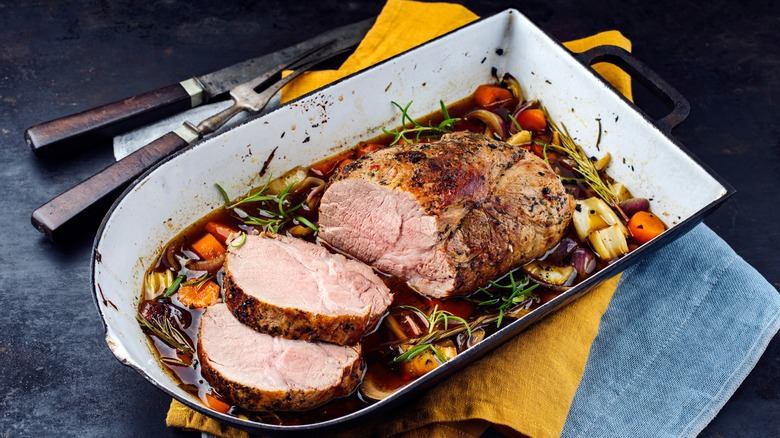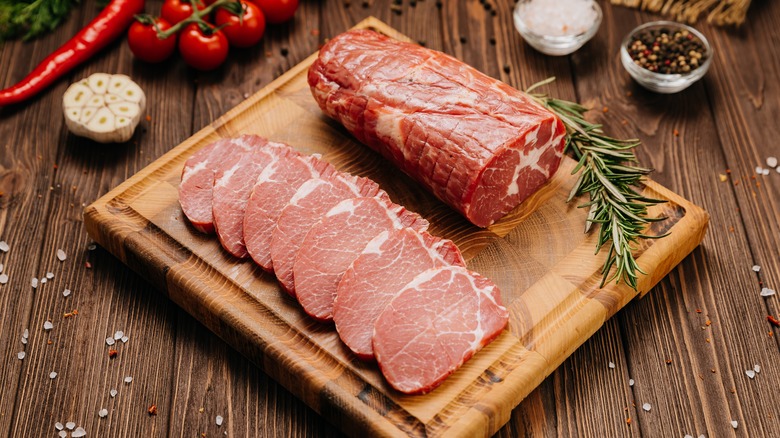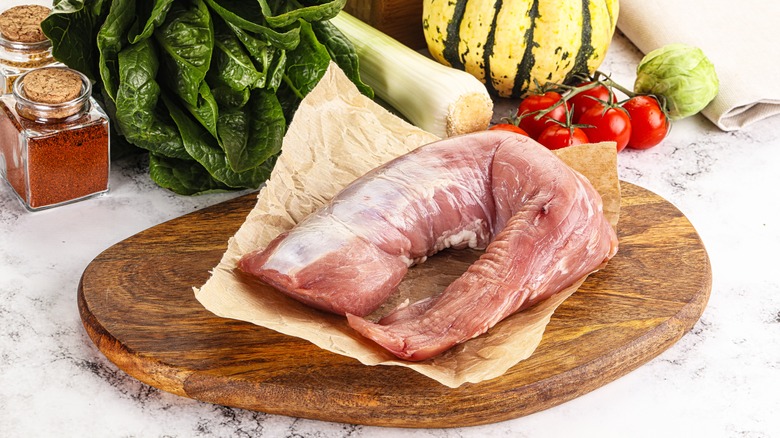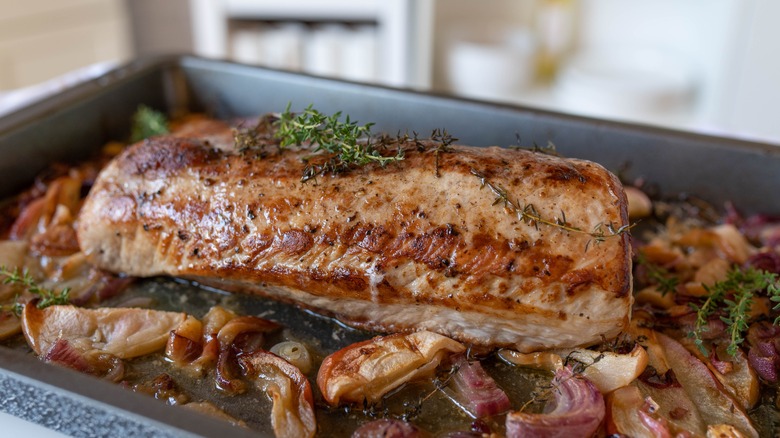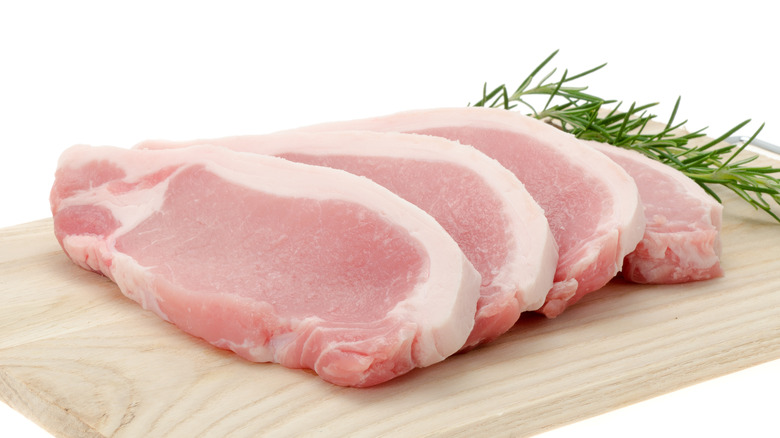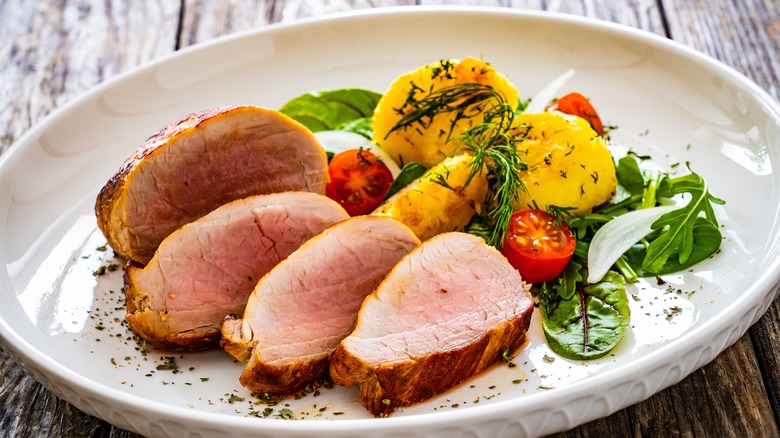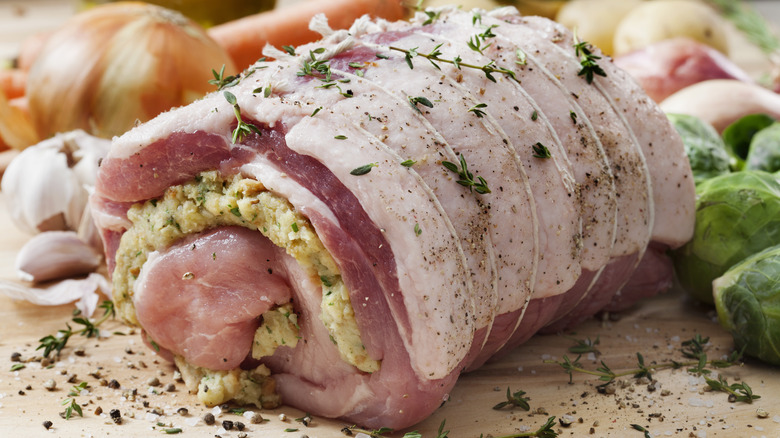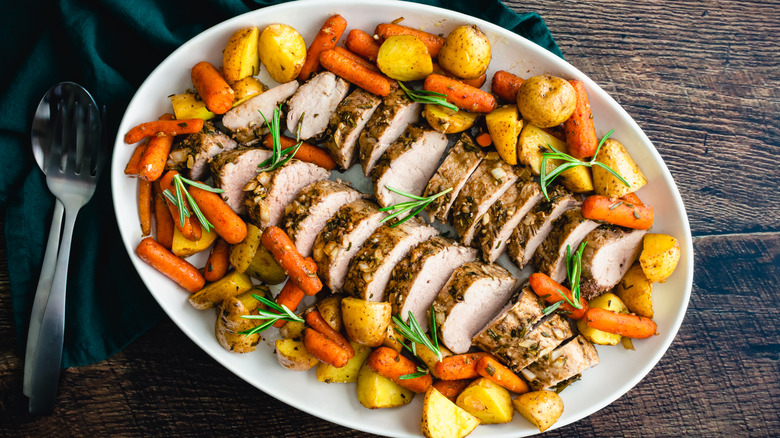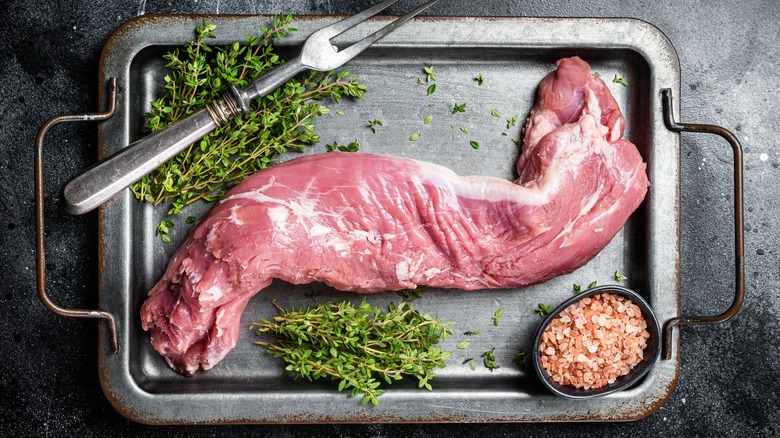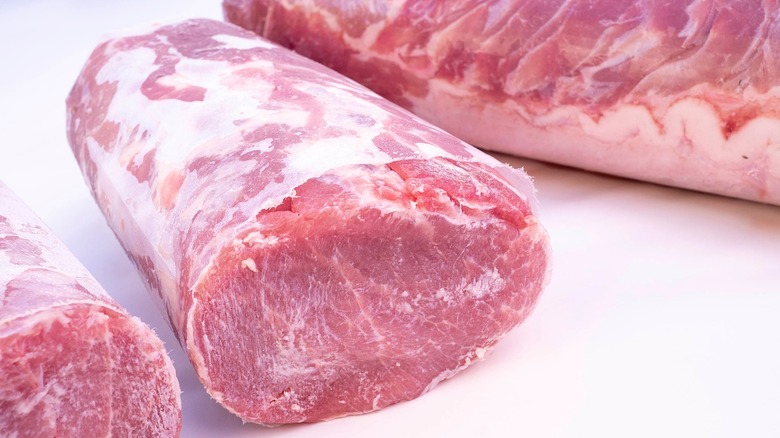What's The Difference Between Pork Loin And Pork Tenderloin?
We may receive a commission on purchases made from links.
While pork is only the third most consumed meat in the U.S. per capita, at 51.1 pounds per person annually, per Statista, its popularity shows no sign of waning. Certainly bacon has a cult following, but two other cuts are immensely popular among consumers, the pork loin and pork tenderloin.
Indeed, in my 18-year career as a professional chef of a fine dining restaurant, they were two of the most frequently requested cuts of meat, not because they were so unusual, but because they took a little finesse to prepare well. Though the pork loin and pork tenderloin hail from similar parts of the pig, they couldn't be more different in terms of texture, flavor, and quality.
In order to prepare these cuts to their maximum potential, one needs to understand not only where on the pig they come from, but how they differ. By taking advantage of the distinct characteristics of the pork loin and pork tenderloin, one can produce a meal that is flavorful, moist, and festive. Read on to discover the ins and outs of cooking and eating the pork loin and tenderloin the way a chef would.
What is a pork loin?
Before launching into what the pork loin is, it is important to understand the basics of pork butchery. The pig is divided into four distinct segments, known as primal cuts: the shoulder, loin, leg, and side or belly. From these, every other cut sold on the market is obtained.
The pork loin is sourced from the loin primal of the pig. This section is located along the back of the animal. Because it gets little exercise during a pig's lifespan, the cuts obtained from this section are quite tender.
The pork loin, also known as the center-cut pork roast, is a lengthy, relatively uniformly-shaped cut of meat that can weigh anywhere from 2 to 5 pounds, depending upon the pig. This cut has a delicate, almost sweet flavor that can melt in your mouth when prepared properly. It can be sold bone-in or boneless, and should have a healthy fat cap encasing it, which helps to keep the otherwise lean meat moist as it cooks.
When sold bone-in, the bones may be Frenched. This is a process where the meat is cut away from the bone, yielding an elegant presentation. A bone-in pork roast that has been Frenched and tied into a circle is called a crown roast of pork, and is a common dish served to a crowd for special occasions. The pork loin can also be cut into boneless or bone-in chops, which are perfect individual servings for grilling or pan-searing.
What is a pork tenderloin?
The pork tenderloin, by contrast, is a small, boneless, roughly 1-pound, svelte segment of meat that is obtained from the muscle that runs the length of the backbone of the pig. Again, since this region receives little to no exercise during a pig's life, it tends to remain relatively tender, if prepared correctly. The best way to describe this cut is to compare it to the beef tenderloin, from which the coveted filet mignon is obtained. Unlike the beef tenderloin, however, this cut lacks the intense intramuscular fat that makes the filet so moist and juicy, making it a challenging piece of pork to cook properly.
This cut is generally sold whole, with its silver skin and any remaining sinew removed. Generally, two tenderloins are wrapped together in a package, though you can obtain single portions by going directly to a butcher. Additionally, pork tenderloins are frequently injected with a sodium solution intended to enhance juiciness and prolong the shelf-life of the meat. This can be avoided by searching for pork tenderloin that is labeled without any added ingredients.
The flavor of pork tenderloin is even milder, which is why it works well with various unusual meat marinades that it can readily absorb, like a sponge. Pork tenderloin that has not been enhanced will generally take on these marinades more readily and the meat should never be overcooked, otherwise it can easily dry out.
Pork loin is larger than pork tenderloin
As noted, an average, boneless pork loin weighs anywhere from 2 to 5 pounds when sold whole. That said, it is frequently divided into smaller segments from which most of the substantial fat cap has been trimmed away. These pork roasts, which typically weigh about 1½ pounds, are ideal for six to eight servings. They are frequently pre-marinated and can also be enhanced with a sodium solution. To obtain an unadulterated pork loin with a more substantial fat cap, purchase a whole one. This can be cut into smaller portions that can be reserved for later use.
Comparatively, a whole pork tenderloin weighs just 1 pound and is always sold whole. A 1-pound pork tenderloin can feed two to three people, depending upon the appetites of those consuming it. A pork tenderloin is typically carved into petite medallions when served, whereas the loin is generally served in thicker, single slices. From a presentation perspective, the tenderloin has a more aesthetically pleasing look when served, though a whole tenderloin is certainly more convenient for a larger crowd.
Pork tenderloin is leaner than pork loin
Though the pork loin and pork tenderloin are both relatively lean cuts, the latter is considered to be more so. Not only is it not encased with a thick layer of fat running along the top of the meat, the flesh itself is less greasy, giving it a delicate, baby pink hue, as opposed to the darker, almost pinkish red color of loin meat, when cooked. Even when most of the fat cap is removed from the pork loin, the meat tends to have a firmer, more toothsome texture than the pork tenderloin when you bite into it.
This difference is most notable when it comes to how these two cuts of pork withstand being cooked beyond a medium-rare to medium doneness. The higher ratio of fat in the pork loin, particularly when the fat cap is left intact, helps to protect the meat, basting it and keeping its flesh juicier, which makes it slightly less susceptible to becoming overcooked. The lack of fat within and surrounding the pork tenderloin makes it incredibly prone to drying out if it is overcooked. This makes it a bit more challenging to prepare and can lead to it being as chewy as the sole of a shoe.
Pork loin needs more time to cook than pork tenderloin
When it comes to cooking pork loin versus pork tenderloin, the former takes longer than the latter because of its size and thickness. Both pork loin and pork tenderloin need to be cooked to a safe minimum temperature of 145 degrees F, as outlined by the USDA. At this stage, the pork will be medium, with a slightly juicy, pink center. This may seem counterintuitive to those who have always been accustomed to cooking their pork well-done, but it is perfectly safe to cook pork to a medium doneness.
Historically speaking, pork was considered problematic because of the presence of the trichina worm, a parasite that can cause a foodborne illness known as trichinosis. A majority of the pork grown for commercial use today is done so in a more controlled environment, which has virtually eradicated the trichina worm. Additionally, according to the National Pork Board, trichina are destroyed at a temperature of 137 degrees F, making it safe to consume if cooked to 145 degrees.
For reference, a pork loin should take roughly 25 minutes per pound of meat to roast in an oven preset at 350 degrees F to be cooked to 145 degrees. A pork tenderloin will take about 20 minutes per pound to achieve the same doneness, depending on your oven. Always measure the internal temperature of pork using a meat thermometer before removing it from the oven and allowing it to rest for 3 minutes.
Pork loin and pork tenderloin are generally prepared differently
Regardless of which you prepare, I always recommend patting pork dry with paper towels and bringing it to room temperature before cooking it. This encourages even cooking and helps the exterior of the meat develop a golden crust. Though you can dry brine either cut with decent results, a pork tenderloin can really benefit from a brief marinade to help build layers of flavor.
To achieve restaurant quality pork tenderloin, you will want to employ a two-stage cooking process. Begin by pan-searing it to help jumpstart the Maillard reaction and develop a crisp texture and umami-rich flavor. Once seared, transfer the meat to the oven to finish cooking. This will produce meat that is flavorful and juicy. Though you can pan-sear a smaller portion of pork loin, this will be impossible when cooking a whole roast, as there isn't a pan large enough for this process.
To obtain a crisp, brown crust, you will want to start the pork loin in an oven set to 400 degrees F for the first 10 minutes of cooking time and reduce the temperature to 350 degrees until the meat is done. It is crucial that you place the pork loin in the oven fat side up so that it remains moist. Alternatively, butterfly the pork loin and stuff it before placing it in the oven. The result is nothing short of spectacular when it is sliced and served for a special occasion.
Pork loin costs less than pork tenderloin
Pork loin is always less expensive than a pork tenderloin. For comparison, you can currently obtain a half pork loin from the Prairie Fresh Natural brand for $1.97 per pound from Walmart, while its pork tenderloin will cost you $3.43 per pound, just under double the price. This reflects both the quality and yield of the pork tenderloin versus the pork loin.
There are a few key things to keep an eye out for when buying pork. The flesh of raw pork should have a dark pink hue, not a pale or grayish one. Its fat needs to be pure white, while bones should be light-colored. Any unusual discoloration can be a sign of spoilage. Additionally, avoid meat that is sitting in an excess amount of liquid. If you are concerned about the meat being injected with a sodium solution, read the label carefully to guarantee the only thing listed is "pork." Lastly, the meat should have no discernible odor, which can be an indication the pork has gone bad.
If you can obtain pork that has a decent amount of intramuscular fat, this will yield a more tender piece of cooked meat. Search for little white flecks of fat that are distributed throughout the flesh. Heritage breeds, like the Berkshire pork from Today Gourmet Foods of NC, are often considered to be superior due to their intense marbling and richer flavor, though they do cost more.
Pork tenderloin is healthier than pork loin
When it comes to the nutrition content of pork, the tenderloin is a superior choice to the loin. In fact, it meets all of the qualifications that classify it as a good option according to the American Heart Association Heart Checkmark guidelines, having below 5 grams of fat, 2 grams of saturated fat, and 480 milligrams of sodium per serving. According to the USDA, a four-ounce serving of pork tenderloin contains 136 calories, 23.3 grams of protein, 3.99 grams of fat, and 58.8 milligrams of sodium.
By contrast, a four-ounce serving of pork loin contains 188 calories, 24.1 grams of protein, 9.41 grams of fat, and 53.1 milligrams of sodium, per the USDA. While this may not meet the criteria set forth by the American Heart Association, it is still a good option for those searching for a high-protein, lean meat. Additionally, all pork is rife with many key nutrients, including iron, magnesium, niacin, phosphorus, potassium, riboflavin, thiamin, zinc, and vitamins B6 and B12.
They can be stored similarly
Generally speaking, pork should be safe to consume if stored in the refrigerator for up to four days. Any longer than that and you will want to consider freezing it. Frozen meat is best if cooked and consumed within three to six months to guarantee the texture doesn't deteriorate.
Though you can freeze a whole pork loin, the best way to store it in the freezer is to divide the meat into smaller portions. The pork loin pieces or pork tenderloin can be wrapped in freezer paper, aluminum foil, or plastic film before being sealed in an airtight container or bag. Make sure to eliminate as much air as possible from the bag before freezing, and label the bag with the date and cut of meat before placing it toward the back of the freezer. Keeping the meat away from the door that opens and closes constantly will guarantee that it does not suffer from freezer burn. Always thaw pork in the refrigerator before cooking it.
Leftover pork loin or pork tenderloin can be kept in the refrigerator for three to four days. Though you can simply reheat it, there are many things to do with leftover pork loin, from putting it in fried rice to adding it to chili. While pork tenderloin can be repurposed into other dishes, if you want to reheat it and keep it moist in the process, try simmering it in liquid.
